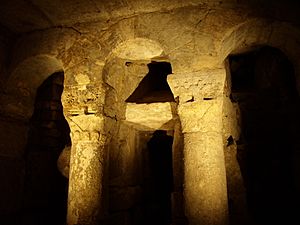Visigothic art and architecture facts for kids
The Visigoths were a powerful group who moved into Hispania (which is now Spain and Portugal) in the year 415. They became the main rulers there. Their kingdom lasted until 711, when the Umayyad conquest of Hispania brought it to an end.
During this time, Visigothic art was very important in the Iberian region. In English-speaking countries, it's often seen as a type of Migration art. However, in Portuguese- and Spanish-speaking countries, it's usually called Pre-Romanesque art.
Visigothic art includes different forms like their unique buildings, beautiful crafts (especially jewelry), and their special writing style called Visigothic script.
Contents
What is Visigothic Architecture?
Visigothic architecture refers to the buildings and structures created by the Visigoths. Most of the remaining examples are churches. These buildings show a distinct style that developed over several centuries.
Early Visigothic Buildings (6th Century)
Not many Visigothic buildings from the 6th century are still standing. Here are a few examples:
- The church of San Cugat del Vallés in Barcelona.
- The hermitage and church of Santa Maria de Lara in Burgos.
- Saint Frutuoso Chapel in Braga, Portugal.
- The church of São Gião in Nazaré, Portugal.
- A few parts of the church at Cabeza de Griego in Cuenca.
Key Features of Visigothic Architecture
Over time, the Visigothic building style became more developed. Even though many examples are now ruins, we can still see their unique features:
- Layout: Buildings often had a basilican shape, which is like a long hall. Sometimes they used a Greek cross plan, which means all four arms are equal length. Occasionally, they combined both shapes. The inside spaces were often divided into many smaller sections.
- Arches: They used horseshoe-shaped arches. These arches did not have a central keystone like many other arches.
- Apse: The apse, which is a rounded or rectangular end part of a church, was usually rectangular and on the outside of the building.
- Columns and Pillars: They used columns and pillars. These often had capitals (the top part of a column) with special designs, often based on Corinthian styles.
- Roofs: They built Barrel vaults, which are like a long tunnel-shaped roof. Where two parts of the building crossed, they sometimes added cupolas (small domes).
- Materials: Marble was often used in their buildings. Walls were typically made of large, cut stone blocks called ashlar. Sometimes, they mixed these stone blocks with Roman brickwork.
- Decorations: The decorations often featured designs of animals or plants.
Important Visigothic Buildings to See
Many examples of Visigothic architecture can still be found today, mostly in rural areas. Here are some of the most well-known:
- Church of San Juan Bautista in Palencia, Spain.
- Crypt of San Antolín inside the Palencia Cathedral, Spain.
- Church of Santa Comba in Bande, Ourense, Spain.
- Chapel of San Xes (or San Ginés) de Francelos in Ribadavia, Ourense, Spain.
- Church of San Pedro de la Mata (now in ruins) in Sonseca, Toledo, Spain.
- Church of Santa María de Melque in San Martín de Montalbán, Toledo, Spain.
- Suso monastery at San Millán de la Cogolla, La Rioja, Spain.
- Basilica of Santa María de Batres in Carranque, Toledo, Spain.
- Hermitage of Santa María in Quintanilla de las Viñas, Burgos, Spain.
- Church of Santa Lucía del Trampal near Alcuéscar, Cáceres, Spain.
- Crypt of the Monastery of San Salvador de Leyre, Navarre, Spain.
- Church of San Miguel de los Fresnos (in ruins) in Fregenal de la Sierra, Badajoz, Spain.
- Interior of the church of San Pedro de la Nave, Zamora, Spain.
- Saint Frutuoso Chapel in Braga, Portugal.
- Church of São Gião in Nazaré, Portugal.
- Church of San Pedro de la Nave in San Pedro de la Nave-Almendra.
More to Explore
See also
 In Spanish: Arte visigodo para niños
In Spanish: Arte visigodo para niños





